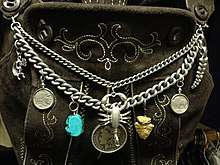Charivari (decorative chain)
Charivari (pronounced "schariwari") is a piece of traditional Bavarian costume jewellery made of solid silver or of rare silver-plated chain, adorned with trinkets, gemstone, coins (or possibly medals), horn discs, carved deer teeth, antlers, animal paws, badger hair, or other game teeth.[1][2]
Origin and use
The name charivari (from the Latin caribaria meaning "mess" or "madness") came into the German-speaking world during the Napoleonic era. At that time it had a secondary, more important, meaning of "pandemonium" or "commotion". This meaning has continued in both English and French until the present day.[3][4]
Bavarian men wear the charivari on the belt of their lederhosen and the women wear it on their dirndl. The charivari traditionally served as jewellery or as a talisman for a successful hunt. For farmers it served as a valuable status symbol. The charivari probably originated from a watch chain, which was attached to the buttonhole of the costume shirt and hung from time to time with various hunting trophies.[5] It could not be bought, was carefully preserved and was passed down in a single family through the generations.
Some ancient charivaris can have a value of up to 10,000 euros (about £ 8,770). They are spread throughout the Eastern Alps and have become fashionable throughout Bavaria once more, being revived by the increasing popularity of local traditional costume clubs. The man's charivari is usually about 33 centimetres (13 in) in length and is made of 825-part or 925-part silver. The chain for women is usually much finer, usually made of so-called rose-plated "Erbsketten" and can also be adorned with small solid silver talismen with small pieces of antler or coins. Some unusual charivaris may be made from very expensive composite antlers or fox teeth. In modern charivaris the animal materials are usually replaced with cast metal trinkets.

Gallery
- Traditional Charivari - silver chain with pendants
- Charivari with many adornments
 Charivari with silver coins from the 19th and early-20th century from Bavaria, Baden and Prussia, including a commemorative coin of King Ludwig II of Bavaria
Charivari with silver coins from the 19th and early-20th century from Bavaria, Baden and Prussia, including a commemorative coin of King Ludwig II of Bavaria Modern charivari worn on jeans
Modern charivari worn on jeans
See also
References
- "German Hunting Amulets (Charivari) | R·Seitz: Talisman". Rseitz.com. 28 July 2014. Archived from the original on 5 March 2016. Retrieved 28 February 2016.
- "A South German Luxurious Charivari, 19th/20th Century Heavy Silver Stock Photo, Picture And Royalty Free Image. Pic. 51538727". Alamy.com. 21 April 2011. Retrieved 28 February 2016.
- "charivari - Wiktionary". En.wiktionary.org. 25 January 2016. Retrieved 28 February 2016.
- "charivari - definition of charivari in English from the Oxford dictionary". Oxforddictionaries.com. Retrieved 28 February 2016.
- "Our Tracht". Alpenlandtaenzer.com. Retrieved 28 February 2016.